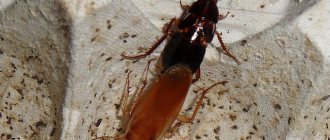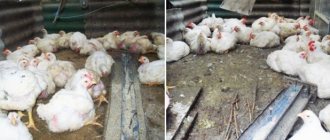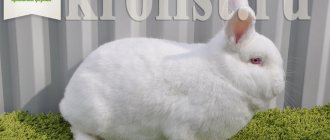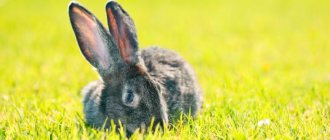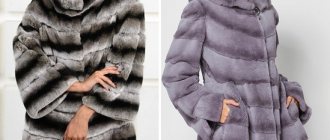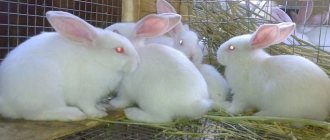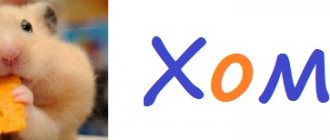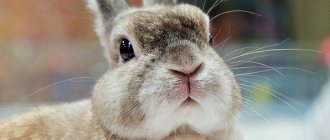The Belgian giant (Flanders, German Risen, Obr, Flemish giant) is the largest breed of rabbit in the world. Rabbits of this breed have been known since the 16th century, when breeders in Belgium (province of Flanders) developed it as a result of many years of work. At the end of the 19th century, rabbits were brought to Germany under the name “Belgian Giant”.
After this, German breeders got involved in the work and for several decades selected rabbits based on size and weight, as well as exterior. In 1937, under the name “Deutsche Riesen”, the breed took on its modern form, but to this day work on improvement is being carried out, the exterior is being formed, new standards are being introduced, which all rabbit breeders without exception should strive for - this is the first step to obtain first place at international and international competitions. regional rabbit shows.
Flandre compares favorably with other breeds with a powerful and long, well-built body, powerful and strong limbs, long wide-open ears with a minimum length of 17 cm. The standard weight of a rabbit is 7-7.5 kg, but with good feeding and maintenance, the Belgian giant “goes away” for 10 kg.
For several years, we have been traveling to Europe several times a year to personally buy rabbits for our private farm Moryak. This article will focus on Flanders rabbits, which were imported from several European countries: Slovakia, Austria, Germany, Holland. Some rabbits are worth mentioning separately.
So in December in Germany at the European Show at Leipzig 2012 we were able to buy breeding rabbits with excellent ratings from well-known breeders. A male was taken from the famous Risen breeder from Austria - Johan Wechselberg - Wechselberger. With a score of 96.5 points. We met this breeder in 2011 at the international Rizen exhibition in the city of Weiden, when we took rabbits from him.
Also, in Leipzig, they took giant rabbits from the excellent collection of rabbit breeder Hegemann Hienz, with scores of 96.5 points.
We bought Risen gelb rabbits. From the breeder Irmler Timo. Score 96 points.
Another released gelb, taken at the Euroshow in Leipzig. From the breeder Renninghoff Johannes, in this collection of 4 rabbits, one female was awarded “European champion” Score 96 points
Two agouti males (96-96 points) from the breeder Knappe Manfred and in this collection there is a European champion.
Two white female Risen with scores of 96.5 and 97 points (winners).
On other trips we visited the farms of Ewald Kremer, Arnold Franz and many, many others.
In general, the rabbits on our farm are from the best breeders in Europe.
The male, brought from Holland, has gained weight well and is working well.
Starting this year, blue Flemish giants began to be imported from Holland. The photo shows a teenager
Content Features
Since all rabbits of meat and skin breeds are quite large, it is not recommended to keep them in cages with mesh floors. The best option for breeding is a floor enclosure; the usable area should be quite impressive (for ordinary rabbits it needs less). You can read more about the types of keeping rabbits in this article.
Regularly clean enclosures of dirt, change bedding, and disinfect.
Males require 100*110 cm of space for normal growth, and females require one and a half times more. In addition, we also need cages with queen cells to support the offspring.
Special attention should be paid to feeding. It should contain enough carbohydrates, proteins, and vitamins. Young animals do not need to be intensively fed, but there should be enough hay and grain in their cages. You can give feed additives to rabbits.
Diet and feeding
The diet depends on the season. But for full development and maintenance of vital functions, rabbits must be regularly given food that contains vitamins (vitamins B and E are the most popular), proteins, fats, carbohydrates and minerals. In summer, adults are recommended to be given wild and slightly dried herbs (tansy, yarrow and others). Daily volume - up to 1.5 kilograms. Rabbits should be given no more than 500 grams of grass per day.
Regardless of the season, the diet should be diluted:
- grass mixtures;
- root vegetables (carrots, corn and others);
- durum apples;
- dried potato greens;
- tree branches.
Branches are necessary for grinding ever-growing teeth. It is recommended to feed beets and carrots in small portions, as this food causes diarrhea. During the harvest period, dried vegetable tops can be introduced into the diet. In winter, up to half of the diet should consist of concentrated and combined feeds. In the off-season, you can dilute the diet with bone and fish meal, and dairy products.
Black-fire
The direct descendants of this breed are the hare and the wild rabbit.
Namely, they inherited their aggressiveness to the black-fire ones. Although, recently, after long crossings, this character trait of animals has softened a little. The breed was first mentioned in 1880 in England. The main difference between these rabbits is their beautiful appearance. The combination of beautiful fur and proper physique produces a spectacular spectacle. The body of the animal is wide and oval. The back is straight. Strong and strong paws. The head is proportional to the body, with beautiful erect ears. The color of the back is black, and the belly is fiery. Due to its beautiful color, this fur goes into production without pre-dyeing. Namely, it constitutes the main value of the breed.
Most often, the weight of an adult is 3.5 kg. This is a relatively good indicator, but still, the breed can hardly be called a meat-skin breed. It is easier to classify it as downy.
Skin breeds
Some breeds of rabbits are valued for their high-quality fur, from which they make blankets, outerwear and much more. These varieties include ermine and satin rabbits.
ermine rabbit
This breed of rabbits has been known in Russia since the 1930s. It is imported from the UK and is famous for its luxurious fur with a “Siamese” pattern. The ermine or Himalayan rabbit has a proportional build and weighs on average 4-5 kg.
Interesting! The Russian ermine rabbit is covered with very thick fur. About 22 thousand hairs grow per 1 cm2 of animal skin.
Peculiarities of the skin direction
At the moment, about 700 breeds of rabbits are known, differing in weight, size, productivity indicators, and hair length. Most meat-skin breeds are characterized by a coat length of 25-35 mm, its composition and thickness is identical to the composition and thickness of the fur of wild relatives. In long-haired breeds, the length of the hairs is about 60 mm or more.
Meat-skin rabbits provide dietary meat and high-quality skins. The hairline is dense.
Be sure to comply with the conditions of keeping and feeding the animals, and ensure the cleanliness of the cages, since these factors have a direct impact on the quality of the fur.
Do not confuse fur breeds and skin breeds! The fur of downy breeds of rabbits has thin, long hair, while that of meat-skin rabbits is dense and shiny.
Causes of hair loss
There are two types of reasons why rabbits lose hair:
The physiological reason includes molting - a natural and necessary process for the normal functioning of animals. Pathological causes are diseases whose side effect is hair loss.
It is not difficult to distinguish natural shedding from a serious disease. With the natural change of coat after hair loss, new thick and healthy hair begins to emerge after a short time. If new hair does not grow back and a bald spot remains, then this is a reason to contact a veterinarian.
induction procedure
The introductory procedure is one of the most popular and effective, especially in cases of urgent need to save the brood from extinction. Such problems often arise due to the fact that rabbits breed in a herd in which there are family ties. The farmer's inaction will quickly deteriorate the herd, making it weak and dying out. One easy way to fix this is to create an introduction. This procedure involves mixing two bloods through mating: an improved female and an improved male; a half-blooded female and an upgradeable male. Rabbits that are bred by this method of crossing can have good indicators: growth in live weight; acceleration of age for slaughter; precocity; reproductive abilities; milkiness. In addition, some farms use “induction” to obtain wool. This method allows you to make it the highest quality and most expensive. The thicker and smoother it is, the higher the price. But such rabbits are bred very rarely. More often than not, the goal of livestock producers is to increase resilience.
Interbreed mating
If you did not devote time to selection, allowed chaotic mating of animals and your rabbits were crushed, then you cannot do without absorption crossbreeding. This method of improving the breed is more complex. But it guarantees that within 1-2 years you will return the animals to the required industrial characteristics. Purchase a breeding male of the desired breed and cross him with females. From the resulting litters, select the strongest and largest females, plant them separately and raise them until the age of sexual maturity. Source: https://otfortlove.ru/skreshchivanie-krolikov-raznykh-porod/#i-8
Feed additives during the molting period
Shedding usually does not leave any consequences, but to prevent brittle hair, dandruff and the rapid growth of a new coat, you can take a supplement containing sulfur. For a rabbit, 0.01 g is enough. drug per day.
Reference! Sulfur should be present in the animal’s food during seasonal, age-related molting, as well as when pathological hair loss occurs.
In addition to pharmaceutical medications, there are natural supplements that can prevent the formation of hairballs in the stomach. Fiber fiber will help maintain normal stomach and intestinal function. Grass and tree leaves in dry and fresh form. Branches of birch, willow or ash contain valuable fiber for your pet.
Agouti color
Agouti color - ambiguity of perception
I don’t know why, but I wanted to write about this color. Probably just because I love him very much (it’s not for nothing that I chose him for the logo of my nursery) I want to express my personal opinion. And also because this color today, in my opinion, is undeservedly not popular, people stereotypically prefer the “cheerful” spotted color. No, I have nothing against him and I myself deal with such rabbits, but I still hope that my article will give an opportunity to take a fresh look at agouti-colored rabbits. However, first, a little theory, where would we be without it? Everyone knows what we are talking about, but probably not everyone realizes that this is not only color, but also the so-called coat pattern, which is directly related to the genetic formula of a particular rabbit. All domestic rabbits in this regard are divided into three groups:
Natural enemies
Agoutis run very fast, covering distances in leaps and bounds. The jump length of this hare is about six meters. Therefore, despite the fact that the humpback hare is a desirable prey for hunters, it is very difficult to catch it.
Agouti's worst enemies are Brazilian dogs, wild cats and, of course, humans. But thanks to good hearing, as well as a keen sense of smell, hares are not easy prey for both predators and hunters. Agouti's only drawback is poor eyesight.
Return to content
